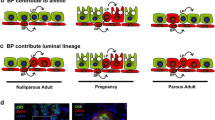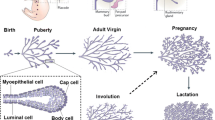Abstract
Evidence that transforming growth factor beta (TGF-β)4 influences pattern formation in the developing mammary gland and negatively regulates ductal growth is reviewed. In the mouse, overexpression of TGF-β transgenes during puberty reduces the rate of growth of the ductal tree and simplifies the pattern of arborization, while expression during pregnancy also interferes with lactation. Expression studies in the normal mouse gland indicate that TGF-β is synthesized in the mammary epithelium, with the three isoforms showing somewhat different spatial and temporal distributions. Exogenous TGF-β applied directly to the glandin situ inhibits epithelial cell division within hours, and strongly stimulates extracellular matrix synthesis over a longer time course. Normal human breast cells as well as certain breast cancer cell lines also secrete TGF-β and are themselves inhibited by it, suggesting an autoregulatory feedback circuit, that in some cases appears to be modulated by estradiol. Taken together, the evidence suggests a model in which growth and patterning of the mammary ductal tree are regulated, at least in part, by TGF-β operating through an autocrine feedback mechanism and by paracrine circuits associated with epithelial-stromal interactions.
Similar content being viewed by others
Abbreviations
- TGF-β:
-
Transforming growth factor beta
- ECM:
-
extracellular matrix
- HMEC:
-
human mammary epithelial cells
- EVac:
-
elvax (ethylene vinyl acetate copolymer)
- ER:
-
estrogen receptor
- WAP:
-
whey acidic protein
- MMTV:
-
mouse mammary tumor virus
References
T. Oka, M. Yoshimura, S. Lavandero, K. Wada, and Y. Ohba (1991). Control of growth and differentiation of the mammary gland by growth factors.J. Dairy Sci. 74:2788–2800.
A. B. Roberts, M. A. Anzano, L. M. Wakefield, N. S. Roche, D. F. Stern, and M. B. Sporn (1985). Type beta transforming growth factor: A bifunctional regulator of cellular growth.Proc. Natl. Acad. Sci. U.S.A. 82:119–123.
S. P. Ethier (1996). Human breast cancer cell lines as models of growth regulation and disease progression.J. Mam. Gland Biol. Neoplasia 1:111–121.
E. Valverius, D. Walker-Jones, S. E. Bates, M. R. Stampfer, R. Clark,et al. (1989). Production of and responsiveness to transforming growth factor beta in normal and oncogene transformed human mammary epithelial cells.Cancer Res. 49:6269–6274.
C. Knabbe, M. E. Lippman, L. M. Wakefield, K. C. Flanders, A. Kasid,et al. (1987). Evidence that transforming growth factor-beta is a hormonally regulated negative growth factor in human breast cancer cells.Cell 48:417–428.
G. Zugmaier, B. W. Ennis, B. Deschauer, D. Katz, C. Knabbe,et al. (1989). Transforming growth factors type beta 1 and beta 2 are equipotent growth inhibitors of human breast cancer cell lines.J. Cell Physiol. 141:353–361.
H. D. Soule, J. Vazguez, A. Long, S. Albert, and M. Brennan (1973). A human cell line from a pleural effusion derived from a breast carcinoma.J. Natl. Cancer Inst. 51:1409–1416.
B. A. Arrick, M. Korc, and R. Derynck (1990). Differential regulation of expression of three transforming growth factor beta species in human breast cancer cell lines by estradiol.Cancer Res. 50:299–303.
C. L. Arteaga, T. C. Dugger, A. R. Winnier, and J. T. Forbes (1993). Evidence for a positive role of transforming growth factor-beta in human breast cancer cell tumorigenesis.J. Cell Biochem. Suppl. 17G:187–193.
S. M. Gorsch, V. A. Memoli, T. A. Stukel, L. I. Gold, and B. A. Arrick (1992). Immunohistochemical staining for transforming growth factor beta 1 associates with disease progression in human breast cancer.Cancer Res. 52:6949–6952.
D. F. Pierce, Jr., A. E. Gorska, A. Chytil, K. S. Meise, D. L. Page,et al. (1995). Mammary tumor suppression by transforming growth factor beta 1 transgene expression.Proc. Natl. Acad. Sci. U.S.A. 92:4254–4258.
P. J. Miettinen, R. Ebner, A. R. Lopez, and R. F. Derynck (1994). TGF-beta induced transdifferentiation of mammary epithelial cells to mesenchymal cells: Involvement of type I receptors.J. Cell Biol. 127:2021–2036.
S. L. Hammond, R. G. Ham, and M. R. Stampfer (1984). Serum-free growth of human mammary epithelial cells: Rapid clonal growth in defined medium and extended serial passage with pituitary extract.Proc. Natl. Acad. Sci. U.S.A. 81:5435–5439.
M. Hosobuchi, M. R. Stampfer, and C. Berkeley (1989). Effects of transforming growth factor beta on growth of human mammary epithelial cells in culture.In Vitro Cell Devel. Biol. 25:705–713.
M. R. Stampfer, P. Yaswen, M. Alhadeff, and J. Hosoda (1993). TGF beta induction of extracellular matrix associated proteins in normal and transformed human mammary epithelial cells in culture is independent of growth effects.J. Cell Physiol. 155:210–221.
C. H. Streuli, C. Schmidhauser, M. Kobrin, M. J. Bissell, R. Derynck, and C. Berkeley (1993). Extracellular matrix regulates expression of the TGF-beta 1 gene.J. Cell Biol. 120:253–260.
A. B. Roberts, K. C. Flanders, P. Kondaiah, N. L. Thompson, E. van Obberghen-Shilling,et al. (1988). Transforming growth factor beta: Biochemistry and role in embryogenesis, tissue repair and remodeling, and carcinogenesis.Rec. Prog. Hormone Res. 44:157–197.
M. Ip and K. M. Darcy (1996). Three-dimensiional mammary primary culture model systems.J. Mam. Gland Biol. Neoplasia 1:91–110.
M. DuBois and J. J. Elias (1984). Subpopulations of cells in immature mouse mammary glands as detected by proliferative responses to hormones in organ culture.Devel. Biol. 106: 70–75.
M. H. Barcellos-Hoff, R. Derynck, M. L. Tsang, and J. A. Weatherbee (1994). Transforming growth factor-beta activation in irradiated murine mammary gland.J. Clin. Invest. 93:892–899.
D. F. Pierce, Jr., M. D. Johnson, Y. Matsui, S. D. Robinson, L. I. Gold,et al. (1993). Inhibition of mammary duct development but not alveolar outgrowth during pregnancy in transgenic mice expressing active TGF-beta 1.Genes Devel. 7:2308–2317.
C. Jhappan, A. G. Geiser, E. C. Kordon, D. Bagheri, L. Hennighausen,et al. (1993). Targeting expression of a transforming growth factor beta 1 transgene to the pregnant mammary gland inhibits alveolar development and lactation.Embo. J. 12:1835–1845.
E. C. Kordon, R. A. McKnight, C. Jhappan, L. Hennighausen, G. Merlino, and G. H. Smith (1995). Ectopic TGF beta 1 expression in the secretory mammary epithelium induces early senescence of the epithelial stem cell population.Devel. Biol. 168:47–61.
G. H. Smith (1996). TGF-β and functional differentiation.J. Mam. Gland Biol. Neoplasia 343–352.
C. W. Daniel, G. B. Silberstein, K. Van Horn, P. Strickland, and S. Robinson (1989). TGF-beta-1-induced inhibition of mouse mammary ductal growth: Developmental specificity and characterization.Devel. Biol. 135:20–30.
M. M. Shull, T. Doetschman, and O. H. Medicine (1994). Transforming growth factor-beta 1 in reproduction and development.Mol. Reprod. Devel. 39:239–246.
G. Proetzel, S. A. Pawlowski, M. V. Wiles, M. Yin, G. P. Boivin,et al. (1995). Transforming growth factor-beta 3 is required for secondary palate fusion.Natl. Genet. 11:409–414.
G. P. Boivin, B. A. O'Toole, I. E. Orsmby, R. J. Diebold, M. J. Eis,et al. (1995). Onset and progression of pathological lesions in transforming growth factor-beta 1-deficient mice.Am. J. Pathol. 146:276–288.
K. B. DeOme, L. J. Faulkin, Jr., and H. A. Bern (1959). Development of mammary tumors from hyperplastic alveolar nodules transplanted into gland-free mammary fat pads of female C3H mice.Cancer Res. 19:515–520.
R. Langer and J. Folkman (1976). Polymers for the sustained release of proteins and other macromolecules.Nature (Lond.) 263:797–800.
G. B. Silberstein and C. W. Daniel (1987). Reversible inhibition of mammary gland growth by transforming growth factor-beta.Science 237:291–293.
C. W. Daniel, K. B. DeOme, J. T. Young, P. B. Blair, and L. J. Faulkin (1968). Thein vivo lifespan of normal and preneoplastic mouse mammary glands: A serial transplantation study.Proc. Natl. Acad. Sci. U.S.A. 61:52–60.
S. Coleman and C. W. Daniel (1990). Inhibition of mouse mammary ductal morphogenesis and down-regulation of the EGF receptor by epidermal growth factor.Devel. Biol. 137:425–433.
G. H. Smith and D. Medina (1988). A morphologically distinct candidate for an epithelial stem cell in mouse mammary gland.J. Cell Sci. 89:173–183.
G. B. Silberstein and C. W. Daniel (1982). Glycosaminoglycans in the basal lamina and extracellular matrix of the developing mouse mammary duct.Devel. Biol. 90:215–222.
A. Rizzino (1988). Transforming growth factor beta: Multiple effects on cell differentiation and extracellular matrices.Devel. Biol. 130:411–422.
J. M. Williams and C. W. Daniel (1983). Mammary ductal elongation: Differentiation of myoepithelium during branching morphogenesis.Devel. Biol. 97:274–290.
C. Streuli, N. Bailey, and M. Bissell (1991). Control of mammary epithelial differentiation: Basement membrane induces tissue-specific gene expression in the absence of cell-cell interaction and morphological polarity.J. Cell Biol. 115:1383–1395.
G. B. Silberstein and C. W. Daniel (1984). Glycosaminoglycans in the basal lamina and the extracellular matrix of serially aged mouse mammary ducts.Mech. Age. Devel. 24:151–162.
G. B. Silberstein, P. Strickland, S. Coleman, and C. W. S. C. Daniel (1990). Epithelium-dependent extracellular matrix synthesis in transforming growth factor-beta 1-growth-inhibited mouse mammary gland.J. Cell Biol. 110:2209–2219.
P. Schmid, D. Cox, G. Bilbe, R. Maier, and G. McMaster (1991). Differential expression of TGF-beta 1,2, and 3 genes during mouse embryogenesis.Development 111:117–130.
F. Millan, F. Denhez, P. Kondaiah, and R. Akhurst (1991). Embryonic gene expression of TGF-beta 1, 2, and 3 suggest different developmental functionsin vivo.Development 111:131–144.
S. D. Robinson, A. B. Roberts, and C. W. S. C. Daniel (1993). TGF beta suppresses casein synthesis in mouse mammary explants and may play a role in controlling milk levels during pregnancy.J. Cell Biol. 120:245–251.
S. D. Robinson, G. B. Silberstein, A. B. Roberts, K. C. Flanders, and C. W. Daniel (1991). Regulated expression and growth inhibitory effects of transforming growth factor-beta isoforms in mouse mammary gland development.Development 113:867–878.
U. I. Heine, E. F. Munoz, K. C. Flanders, L. R. Ellingsworth, P. H. Lam,et al. (1987). Role of transforming growth factor beta in the development of the mouse embryo.J. Cell Biol. 105:2861–2876.
S. A. Lehnert and R. J. Akhurst (1988). Embryonic expression pattern of TGF-beta type-1 RNA suggests both paracrine and autocrine mechanisms of action.Development 104:263–273.
R. J. Akhurst, S. A. Lehnert, A. Faissner, and E. Duffie (1990). TGF beta in murine morphogenetic processes: The early embryo and cardiogenesis.Development 108:645–656.
A. B. Roberts and M. B. Sporn (1990). The transforming growth factor-betas. In M. B. Sporn and A. B. Roberts (eds.),Peptide Growth Factors and Their Receptors, Springer-Verlag, Heidelberg.
C. W. Daniel, G. B. Silberstein, and P. Strickland (1987). Direct action of 17 beta-estradiol on mouse mammary ducts analyzed by sustained release implants and steroid autoradiography.Cancer Res. 47:6052–6057.
S. D. Robinson, G. B. Silberstein, A. B. Roberts, K. C. Flanders, and C. W. S. C. Daniel (1991). Regulated expression and growth inhibitory effects of transforming growth factor-beta isoforms in mouse mammary gland development.Development 113:867–878.
G. B. Silberstein, K. C. Flanders, A. B. Roberts, and C. W. S. C. Daniel (1992). Regulation of mammary morphogenesis: Evidence for extracellular matrix-mediated inhibition of ductal budding by transforming growth factor-beta 1.Devel. Biol. 152:354–362.
E. Ruoslahti and Y. Yamaguchi (1991). Proteoglycans as modulators of growth factor activities.Cell 64:867–869.
Y. Yamaguchi, D. M. Mann, and E. Ruoslahti (1990). Negative regulation of transforming growth factor-beta by the proteogly-can decorin.Nature 346:281–284.
Y. Yamaguchi and E. Ruoslahti (1988). Expression of human proteoglycan in chinese hamster ovary cells inhibits cell proliferation.Nature 336:224–246.
M. H. Barcellos-Hoff Latency and activation in the control of TGF-β.J. Mam. Gland Biol. Neoplasia 1:353–363.
Y. Friedmann, C. A. Daniel, and P. Strickland (1994). Hox genes in normal and neoplastic mouse mammary gland.Cancer Res. 54:5981–5985.
J. M. Bradbury, P. A. Edwards, C. C. Niemeyer, and T. C. Dale (1995).Wnt-4 expression induces a pregnancy-like growth pattern in reconstituted mammary glands in virgin mice.Devel. Biol. 170:553–563.
B. J. Gavin and A. P. McMahon (1992). Differential regulation of the Wnt gene family during pregnancy and lactation suggests a role in postnatal development of the mammary gland.Mol. Cell Biol. 12:2418–2423.
S. J. Weber-Hall, D. J. Phippard, C. C. Niemeyer, and T. C. Dale (1994). Developmental and hormonal regulation of Wnt gene expression in the mouse mammary gland.Differentiation 57:205–214.
J. Russo and I. H. Russo (1987). Development of the human mammary gland. In M. C. Neville and C. W. Daniel (eds.),The Mammary Gland: Development, Regulation, and Function, Plenum Press, New York, pp. 67–93.
Author information
Authors and Affiliations
Corresponding author
Rights and permissions
About this article
Cite this article
Daniel, C.W., Robinson, S. & Silberstein, G.B. The role of TGF-β in patterning and growth of the mammary ductal tree. J Mammary Gland Biol Neoplasia 1, 331–341 (1996). https://doi.org/10.1007/BF02017389
Issue Date:
DOI: https://doi.org/10.1007/BF02017389




